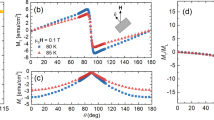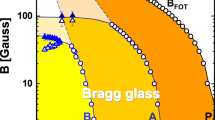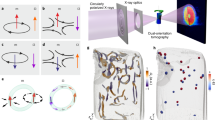Abstract
In 1967, Reatto and Chester1 proposed that solid helium-4 might exhibit superfluidity, and in 1970, Leggett2 suggested what was thought to be a definitive experimental test: to find non-classical rotational inertia in a toroidal sample. More than three decades later, the observation by Kim and Chan3,4 of exactly that effect generated great interest and has been repeated and confirmed by a number of groups. However, many attempts to find actual superflow in truly solid samples have failed. Here, I draw an analogy with a second example of anomalous response to vorticity in a dissipative fluid, the vortex liquid phase in the pseudogap region of high-temperature superconductors, and propose that the solid helium experiments have been mischaracterized: what is observed is not supersolidity but an incompressible vortex liquid. This state is distinct from a conventional liquid in that its properties are dominated by conserved supercurrents flowing around a thermally fluctuating tangle of vortices.
Similar content being viewed by others
Main
In the past two years, we have been confronted with puzzling data involving ‘non-classical’ responses to vorticity in two very different physical systems. One has garnered (justifiably) a great deal of attention: the observations, by Kim and Chan4, of NCRI (Leggett’s term2: non-classical rotational inertia) in samples of solid He-4.
Attention for the second system has been confined mostly to specialists in the field of high transition-temperature, Tc, superconductivity. In these superconductors there is a phase for T>Tc, in which anomalous properties persist up to quite high temperatures—it is called the ‘pseudogap’ phase. It has recently been shown5,6 that in the lower portion of this phase, the in-plane diamagnetic susceptibility is large and nonlinear up to a certain fairly definite ‘onset’ field and temperature, somewhat lower than the crossover, T*, that bounds the pseudogap region. That this behaviour is due to vortex-like currents is demonstrated by the earlier observation7,8, of a large and nonlinear Nernst effect, continuous with that observed in the high-field flux-flow region, and ascribable to viscous flow of vortices along a thermal gradient. Above Tc, the susceptibility and Nernst signal track each other closely.
The moment of inertia can be thought of as a rotational susceptibility

where M is angular momentum and Ω is angular velocity. Thus, nonlinear susceptibility and NCRI are similar phenomena. The latter could be characterized as nonlinear rotational susceptibility rather than as NCRI. The two experimental examples can be shown to be similar even in functional form if we note that M/B often varies as ln B over an intermediate range of the magnetic field, B, whereas δ I falls off linearly with ln Ω at larger Ω (ref. 4).
I believe that in both of these phases the dynamics are controlled by thermally excited, fluctuating, quantized vortex tangles: they are vortex liquids. The concept of vortex liquid is not a new one: it is implicit in the Kosterlitz–Thouless9 theory of the superfluid phase transition in two dimensions, where the superfluid phase transition occurs via the thermal proliferation of vortices. The melting of the Abrikosov lattice of flux lines is known to be the transition mechanism at higher fields in high-Tc superconductors10. The vortex liquid is a relatively familiar concept in this high field range, and there have been suggestions that it is a distinct phase11, but before our recent work there has not been a very clear characterization of it or its dynamics. I am suggesting that this entire region in the field-temperature phase diagram is not just some consequence of either gaussian superconducting fluctuations in a basically normal fluid, or of a melted array of Abrikosov vortices. This may be formally characterized by its non-analytic response to magnetic field, a response that vanishes outside of a definite region of temperature and field. Nguyen and Sudbo12 have also suggested the existence of a distinct vortex liquid phase above the superfluid transition in their simulations, but have not discussed dynamics. (See also Franz and Tesanovic13.)
The transition temperature, Tc, for a superfluid is normally described in terms of the x–y model, where the order parameter is a phase φ and the effective hamiltonian is proportional to  . The theory of the superfluid transition for the Bose liquid has been recast in vortex form by Williams14, following earlier suggestions by Onsager, Feynman and Elser. This seems also to be the case for the high-Tc superconductors, empirically15 and now theoretically16; the energy gap persists for a considerable range above Tc, unlike conventional superconductors, and Tc is caused by phase disordering. There is good empirical reason to believe11 that quasiparticle currents are dominated by the supercurrents at least near Tc.
. The theory of the superfluid transition for the Bose liquid has been recast in vortex form by Williams14, following earlier suggestions by Onsager, Feynman and Elser. This seems also to be the case for the high-Tc superconductors, empirically15 and now theoretically16; the energy gap persists for a considerable range above Tc, unlike conventional superconductors, and Tc is caused by phase disordering. There is good empirical reason to believe11 that quasiparticle currents are dominated by the supercurrents at least near Tc.
The x–y model, however, does not really describe the disordered superfluid, because the order parameter is not a simple classical vector but a quantum dynamical variable. There are supercurrents whose velocity is given by

where m is the appropriate boson mass.
The crucial concept here is that there is a finite superfluid density, ρs, which has an equilibrium value at any temperature below the onset and at any field (for superconductors) below Hc2, the field at which vortex cores overlap and superconductivity is destroyed. Hence, there is a term in the free energy

This ensures that the superfluid is approximately incompressible for the relatively slow motions and longer space scales of the phase fluctuations caused by vortices, so that (equation (1)),

is coarse-grained over such scales. (Our ρs is not the conventional macroscopic quantity giving the penetration depth, which is its average over phase fluctuations, but is defined microscopically by equation (1).)
This means that the state of the vortex fluid at any given instant can be completely characterized by an array of singular lines (vortices) around which the phase rotates by 2π. In the homogeneous fluid or in the absence of strong pinning forces, these vortex lines will move with the local velocity of the fluid due to all of the other lines. I have been able17 to give a reasonably good quantitative account of the Nernst observations on the pseudogap phase of high-Tc superconductors, as well as of the resistivity in this phase, using this vortex fluid picture. The essential point of these transport phenomena is that dissipation is caused by the thermal fluctuations of the supercurrents with a mean correlation time  , when T is well above Tc. (k is Boltzmann’s constant.) The observations of ‘Fermi arcs’ by Campuzano and coworkers18 in the pseudogap phase also receives a simple explanation in terms of the time-fluctuating phase of the energy gap.
, when T is well above Tc. (k is Boltzmann’s constant.) The observations of ‘Fermi arcs’ by Campuzano and coworkers18 in the pseudogap phase also receives a simple explanation in terms of the time-fluctuating phase of the energy gap.
The key property of the vortex fluid phase is that as long as the phase φ is definable and satisfies the constraint (equation (2)), the extra vortices caused by the overall rotation of the sample, or equivalently by an external magnetic field in the superconductor case, cannot be screened away by polarization of the background thermal fluid of vortices. For each quantum unit of flux or circulation, there will be exactly one extra quantized vortex running entirely through the sample with its extra rotation by 2π along any circumscribing path, and therefore it will have its extra velocity implied by equation (1),

Each of these extra vortices has a self-energy given by integrating the extra kinetic energy ρsv2/2 over the sample:

a is the vortex core size, presumably microscopic in the cases of interest. The extra currents blend in to the overall rotation at the scale of the distance between them, so there is an upper limit, R, for the logarithmic integral; what is special about the vortex liquid are the fluctuations in current caused by the fact that the vorticity is quantized. This causes the non-classical diamagnetism or rotational inertia. I believe that the condition of finite, conserved superfluid density is likely to be equivalent to that in ref. 12, that the line tension of vortex lines be finite.
Below Tc, the extra currents and velocities implied by equation (3) are progressively screened out as T→Tc by the effects of thermally excited vortex pairs—but, significantly, not to zero at Tc, as in ref. 9. But above Tc, interactions between vortices are less important than entropic considerations, and the screening effect disappears: the vortices are randomly distributed.
The evidence for vortex fluid behaviour in solid He is even less accepted and the following description of the situation is somewhat conjectural. Huse and coworkers19 first pointed out that the observations of Kim and Chan in refs 3, 4 seem not to be what is expected of a true superfluid but rather represent the dispersion at a dissipation peak above the superfluid Tc, in analogy with the observations of Kosterlitz–Thouless behaviour in He films20. We proposed, and supported with experimental evidence, the idea that solid He is an incommensurate three-dimensional density wave rather than a true solid, with the actual helium capable of flowing as a fluid through this density wave. In the presumed ground state, this flow is that of a superfluid, but above Tc (which we estimate is <0.02 K) it is a vortex fluid. This flow has a superfluid density

and velocity

The dynamical variable that characterizes the flow of the helium relative to the lattice is the phase φ(r), which in turn is entirely described by a network of vortex lines plus uniform motion. There is only one set of Goldstone bosons, the phonons of the lattice, and actual compressional modes of the relative motion with respect to the lattice are at high frequency. When the lattice is in uniform motion without the fluid, it carries only (1−MHe/M) of the mass. For the entire solid to rotate rigidly, it must contain a number of vortices equal to Ω MHe/h per unit area.
My suggestion is that the torsional vibration frequency 1,000 Hz matches the rate at which vortices can move into and out of the sample precisely at the temperature of maximum dissipation (see Fig. 1). At lower temperatures, the rate of vortex motion is too slow and the moment of inertia is only that of the lattice, and hence is reduced by the ratio 1−MHe/M. At higher temperatures, vortices flow in easily and the moment of inertia is normal.
Estimating the rate of motion of vortices in the pure solid using the methods of ref. 17 seems to result in too rapid motion. He-3 impurities should act as quite efficient pinning centres, and this is the most likely mechanism for the observations by Kim and Chan3,4 that the effects are very He-3 dependent, and disappear when He-3 is completely absent. It may be that the vortices would have to carry the He-3 along with them, which would slow their motion severely. Structural defects, if present, would be less effective in pinning vortices, although the fact that annealing affects the results suggests some role in slowing vortex motion.
The close analogy between the Nernst effect and the Chan effect is striking. In both cases, a current of vortices is driven, in the one case by the thermal gradient and in the other by the alternating torsional velocity. What is actually measured is the viscous resistance to this flow, and the size of the response is proportional to the logarithmic energy of the vortices. The number of driven vortices is enormously different, of course: a small integer in Chan’s case, of order 109 in the Nernst effect.
Structural defects are often suggested as an ‘explanation’ of the Chan experiments. The coincidence that the magnitude of the ‘critical’ velocity corresponds to a small number of vorticity quanta argues against this; also, it is hard for me to understand why structural defects should respond specifically to rotation, mimicking the effects of vortices, and not, for instance, to steady pressures such as have been applied in various unsuccessful experiments. It is interesting to note that superflow along a network of dislocation lines or grain boundaries might well obey the above equations for a vortex liquid, although I find this alternative explanation for the observations less plausible. An experiment by Rittner and Reppy21 is adduced as evidence for the defect theory, but the experimental conditions of Rittner and Reppy’s experiment differ substantively from Chan’s; particularly, with a higher velocity and a larger, cubic cell, Rittner and Reppy’s sample has orders of magnitude more vortices in it.
Clearly the crucial experiment for our hypothesis is to change the torsional vibration frequency, holding all other variables constant. This has not been done. It would seem to be urgent to do so, because no other hypothesis yet proposed is consistent with any appreciable fraction of the data.
In summary, I am proposing that the extensive observations of Ong and Wang and coworkers6,7,8 on the pseudogap phase of cuprate superconductors constitute the discovery of the vortex fluid phase conjectured by Feigel’man11 and by Nguyen and Sudbo12; and I conjecture that the observation of NCRI in quantum solids by Kim and Chan3,4 constitutes a rediscovery of this phase in a uniquely interesting system.
References
Reatto, L. & Chester, G. V. Phonons and the properties of a Bose system. Phys. Rev. 155, 88–100 (1967).
Leggett, A. J. Can a solid be superfluid? Phys. Rev. Lett. 25, 1543–1546 (1970).
Kim, E. & Chan, M. H. W. Probable observation of a supersolid helium phase. Nature 427, 225–227 (2004).
Kim, E. & Chan, M. H. W. Observation of superflow in solid helium. Science 305, 1941–1944 (2004).
Li, L. et al. Strongly nonlinear magnetization above Tc in BSCCO. Europhys. Lett. 72, 451–457 (2005).
Wang, Y. et al. Field-enhanced diamagnetism in the pseudogap state of a cuprate superconductor in an intense magnetic field. Phys. Rev. Lett. 95, 247002 (2005).
Wang, Y. et al. Dependence of upper critical field on pairing in cuprates. Science 299, 86–89 (2003).
Wang, Y., Li, L. & Ong, N. P. Nernst effect in high-Tc superconductors. Phys. Rev. B 73, 024510 (2006).
Kosterlitz, J. M. & Thouless, D. J. Ordering, metastability, and phase transitions in two-dimensional systems. J. Phys. C 6, 1181–1203 (1973).
Zeldov, E. et al. Thermodynamic observation of first-order vortex-lattice melting transition in BiSCCO. Nature 375, 373–376 (1995).
Feigel’man, M. V. & Ioffe, L. Non-local screening in a vortex line liquid. Preprint at <http://www.arxiv.org/abs/cond-mat/9403032> (1994).
Nguyen, A. K. & Sudbo, A. A new broken U(1) symmetry in extreme type-II superconductors. Europhys. Lett. 46, 780–789 (1999).
Franz, M. & Tesanovic, Z. Algebraic Fermi liquid from phase fluctuations. Phys. Rev. Lett. 87, 257003 (2001).
Williams, G. A. Vortex ring model of the superfluid λ transition. Phys. Rev. Lett. 59, 1926–1929 (1987).
Pasler, V. et al. 3D-XY critical fluctuations of the thermal expansivity in detwinned YBCO single crystals near optimal doping. Phys. Rev. Lett. 81, 1094–1097 (1998).
Anderson, P. W. Physics of the pseudogap state: Spin-charge locking. Phys. Rev. Lett. 96, 017001 (2006).
Anderson, P. W. Dynamics of the vortex fluid in cuprate superconductors: The Nernst effect. Preprint at <http://www.arxiv.org/abs/cond-mat/0603726> (2006).
Kanigel, A. et al. Evolution of the pseudogap from Fermi arcs to the nodal liquid. Nature Phys. 2, 447–451 (2006).
Anderson, P. W., Brinkman, W. F. & Huse, D. Thermodynamics of an incommensurate quantum crystal. Science 310, 1164–1166 (2005).
Bishop, D. J. & Reppy, J. Study of the superfluid transition in two-dimensional 4He films. Phys. Rev. Lett. 40, 1727–1730 (1978).
Rittner, A. S. C. & Reppy, J. D. Observation of classical rotational inertia and non-classical supersolid signals in solid 4He below 250 mK. Phys. Rev. Lett. 97, 165301 (2006).
Acknowledgements
I must acknowledge valuable discussions with my collaborators D. Huse and W. F. Brinkman, and also with S. Sondhi and V. Oganesyan (the latter of whose ideas, together with those of S. Ragu, suggested the absence of screening in the vortex liquid). None of the above need take any responsibility for my conclusions. Experimental information from M. Chan, Y. Wang and L. Li, and many discussions of theory and experiment with N. P. Ong, have been vital.
Author information
Authors and Affiliations
Corresponding author
Ethics declarations
Competing interests
The author declares no competing financial interests.
Rights and permissions
About this article
Cite this article
Anderson, P. Two new vortex liquids. Nature Phys 3, 160–162 (2007). https://doi.org/10.1038/nphys539
Received:
Accepted:
Published:
Issue Date:
DOI: https://doi.org/10.1038/nphys539
This article is cited by
-
Mass Flux Experiments in Solid \(^4\)He: Some History, Recent Work and the Current Status
Journal of Low Temperature Physics (2019)
-
Vortex dynamics of counterpropagting laser beams in photorefractive materials
Optical and Quantum Electronics (2018)
-
Small Fermi surfaces and strong correlation effects in Dirac materials with holography
Journal of High Energy Physics (2017)
-
Non-Ohmic Electrical Transport in the Vicinity of the Superconducting Transition: Implications for the Study of the Phase Diagram of the Underdoped Cuprate Superconductors
Journal of Superconductivity and Novel Magnetism (2015)
-
EPR Study of the Local Magnetic Field Distribution over the Bi2Sr2Ca1−x Y x Cu2O8+y Crystal Surface above the Superconducting Transition Temperature
Applied Magnetic Resonance (2015)




